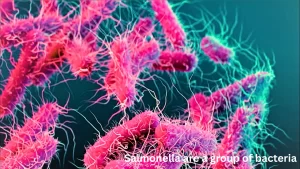Salmonella typhi and Salmonella typhimurium 6 Differences
An Overview of Salmonella typhi and Salmonella typhimurium
Salmonella typhi and Salmonella typhimurium, Salmonella is a broad group of bacteria with several important species. Two of the most widely spread are Salmonella typhi and Typhimurium, both associated with human diseases but differing significantly in terms of clinical manifestations, epidemiology, and global impact.

Salmonella typhi is responsible for typhoid fever, an infectious systemic illness primarily affecting the digestive tract. The bacteria possess unique traits which distinguish them from other salmonella serovars – they feature rod-shaped shapes with Gram-negative qualities and possess rod morphologies.
Salmonella typhi is spread primarily through food or water contamination and consumption by humans – oftentimes, this form of transmission occurs more commonly in regions with poor sanitation and hygiene practices. Symptoms of Typhoid fever include high fever, Abdominal pain, Headache and Gastrointestinal disturbances.
In severe cases it can result in complications affecting various organs including Liver, Spleen, and Intestines. Diagnosis of typhoid fever can usually be confirmed through blood or stool culture and serological testing; serological tests can then identify specific antibodies.
Antibiotic therapy remains the cornerstone of treatment. Antibiotic-resistant strains present difficulties. As a preventative measure and to help curb and eliminate this illness. Vaccinations is available and efforts are currently being undertaken globally in an attempt to control and eradicate it.
Salmonella typhimurium can cause infections both in animals and humans. The serotype can be found in a lot of cases with products from animals or animal origins consumed. This type of serotype typically transmits to people by infected raw or uncooked meals, which includes meat as well as eggs. For poultry, the microbe is transmitted by birds to birds via the droppings of their birds.
Salmonella Typhimurium is the cause of Gastroenteritis or Intestinal inflammation. Gastroenteritis can cause vomiting, diarrhea along with fever as well as abdominal cramps. The symptoms can last for until seven days.
The diagnosis of gastroenteritis is determined by tests, physical examinations, the body fluids and stool as well as culture-based methods (SM2 Chromogenic Media, Rappaport Vassiliadis broth), biochemical tests (API-20E system) as well as serogrouping in KW. The treatment options for gastroenteritis are diarrhoea remedies (medications like Ioperamide (Imodium A-D) as well as antibiotics like Ciprofloxacin.
Differences between Salmonella typhi and Salmonella typhimurium
| Topic | Salmonella typhi | Salmonella typhimurium |
|---|---|---|
| Clinical Presentation | Causes typhoid fever; systemic illness with high fever, abdominal pain, headache, and gastrointestinal disturbances. | Causes gastroenteritis with symptoms such as diarrhea (often bloody), abdominal cramps, nausea, and vomiting. |
| Disease Burden and Epidemiology | More prevalent in regions with inadequate sanitation; associated with a significant disease burden, especially in developing countries. | More widespread globally; a common cause of foodborne illnesses, with a high number of reported cases. |
| Host Specificity | Primarily infects humans; adapted to survive and replicate within the human host. | Broader host range; can infect various animal species, including humans. |
| Transmission | Primarily transmitted through the ingestion of contaminated food or water; spread through human-to-human contact or the consumption of contaminated food/water. | Mainly transmitted through the consumption of contaminated food, particularly raw/undercooked animal products; can also be transmitted through contact with animals, their feces, or contaminated environments. |
| Diagnosis | Diagnosed by isolating and identifying Salmonella typhi from blood, stool, urine, or bone marrow samples; blood culture and serological tests are common diagnostic methods. | Diagnosed by isolating and identifying Salmonella typhimurium from stool samples through culture and biochemical tests; serotyping determines the specific serovar. |
| Antibiotic Resistance | Some strains have developed resistance to multiple antibiotics, posing challenges for treatment. | Antibiotic resistance is a concern, but the range of susceptibility to antibiotics is generally wider compared to Salmonella typhi. |

Similarities between Salmonella typhi and Salmonella typhimurium
Salmonella typhi and Salmonella typhimurium, despite their differences, also share some similarities.
Here are some of the key similarities between Salmonella typhi and Salmonella typhimurium:
- Genus and Species: Both Salmonella typhi and Salmonella typhimurium belong to the Genus Salmonella enterica complex of bacteria.
- Gram-Negative Bacteria: Both serovars of S. aureus are Gram-negative bacteria, meaning that their outer membrane contains an outer peptidoglycan layer and contains only minimal amounts of outer peptidoglycan.
- Enteric Pathogens: Both Salmonella typhi and Salmonella typhimurium are enteric pathogens, meaning they primarily infect the gastrointestinal tract.
- Salmonellosis: Both serovars of Salmonella can lead to salmonellosis, an umbrella term for all illnesses caused by Salmonella infection; however, each serovar may manifest differently and cause different clinical presentations and severity levels of symptoms.
- Salmonella Typhi and Tyhimurium Transmission through Food and Water: Both strains of Salmonella can be passed along via infected food and water sources; improper handling or undercooking animal products like poultry, eggs or meat is one way of spreading infection from either serovar.
- Laboratory Diagnosis: Similar laboratory techniques are utilized when diagnosing infections caused by Salmonella typhi and Salmonella typhimurium bacteria, including culture and identification techniques such as biochemical tests or serotyping to confirm their presence in clinical samples.
- Public Health Importance: Both serovars can have serious ramifications on public health, with efforts aimed at preventing and controlling infections caused by Salmonella typhi and Salmonella typhimurium. This involves measures such as food safety measures, improving sanitation practices, and spreading public awareness campaigns.

Conclusion
Salmonella Typhi and Typhimurium are two serovars within Salmonella enterica species that cause distinct infections in individuals.
Salmonella Typhi is well known to cause severe cases of Typhoid Fever with serious consequences while Salmonella Typhimurium usually results in gastroenteritis symptoms. While Typhi is more prevalent in regions without adequate sanitation systems and Typhimurium occurs worldwide. Foodborne illnesses caused by both bacteria strains often results from their co-infection.


